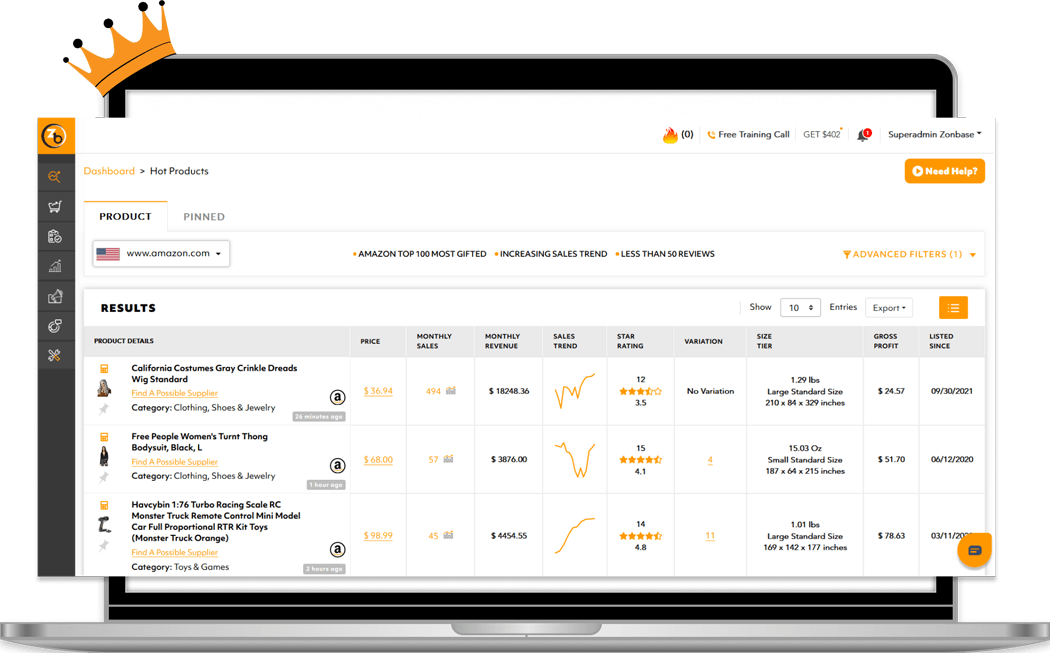What is Hot Products?
The Hot Products tool is a unique Amazon product trends tool
that provides an hourly-updated list of trending hot products
on Amazon. Having trouble coming up with product ideas?
You can start with the Hot Products list.
Get Instant Access to the Hottest Amazon Products
Hot Products are products in Amazon’s Top 100 Most Gifted that
have an increasing sales trend and fewer than 50 reviews: the
perfect combination of high demand and low competition.
The Hot Products tool shows you more information about these
trending products, such as their price, sales history, number of
reviews, and more.


Target The Best of The Best with Advanced Filters
Narrow your search for the most profitable products. Choose the
product categories you prefer. Specify your criteria using
advanced filters such as price, number of reviews, average
monthly units sold, monthly revenue, and more.
Reliable Up-to-date Data You Can Trust
Our database is being updated every hour, ensuring that you
get the most accurate data and make the best data-driven
decisions for your business.

Find reliable suppliers for your chosen product
The Hot Products tool connects you to Alibaba, the leading B2B eCommerce platform for wholesale trade, allowing you to easily access possible manufacturers/suppliers for the trending product you choose.

Try Out Our Other Product Research Tools

ZonResearch - Find potential products in Amazon’s vast database that match your business needs and preferences

Zonbase Chrome Extension - View behind-the-scenes information about the products on Amazon’s search results page
Frequently Asked Questions
A.The Hot Products tool utilizes advanced algorithms that analyze factors like sales velocity, recent review trends, and sales history to identify products with increasing popularity on Amazon. This algorithmic approach ensures accurate and up-to-date results.
A. The Hot Products list is updated every hour, providing you with real-time insights into the latest trending products on Amazon. This frequent updating ensures that you have the most current data to base your decisions on.
A. Yes, the Hot Products tool allows you to narrow down your search by selecting specific product categories that align with your business preferences. This customization helps you target the niches that matter most to you.
A. Advanced filters are powerful tools that enable you to fine-tune your product search based on various criteria, such as price range, number of reviews, average monthly units sold, and more. These filters assist you in identifying products that meet your specific profit goals.
A. The Hot Products tool seamlessly integrates with Alibaba, a renowned B2B eCommerce platform. Once you've identified a trending product, you can easily access potential manufacturers and suppliers through Alibaba to explore sourcing options.
A. Currently, the Hot Products tool is designed to provide insights exclusively for Amazon's marketplace. It focuses on helping you discover high-demand, low-competition products within the Amazon ecosystem.
A. There is no predefined limit to the number of products you can track. You can explore as many trending products as you want, tailoring your research to suit your business goals.
A. The Zonbase Chrome Extension complements the Hot Products tool by providing you with in-depth insights into the products displayed on Amazon's search results page. It offers behind-the-scenes data that can further enhance your product research strategy.
A. Getting started is easy! Simply sign up for a Zonbase account, and you'll gain access to the Hot Products tool and other powerful features. From there, you can explore trending products, set filters, and make data-driven decisions to boost your Amazon business.

Create a Free ZonBase Account
Take action now towards building a successful Amazon business by signing up
for our
7-Day Free trial







